Alan Arnette
is an Alzheimer's advocate for individuals, their families
and anyone impacted by this disease through his professional
speaking, climbing and website.
His objectives for the Memories are Everything® climbs
are:
- Educate the public, especially youth, on the
early warning signs and how to prepare
- Increase awareness that Alzheimer's Disease has
no cure
- Raise research money for Alzheimer's non-profits
His projects include:
Over $250,000 raised for Alzheimer's
non-profits and
50 million people reached through my climbs |
 • NO
CURE, always Fatal • NO
CURE, always Fatal
• No easy, inexpensive method of early detection
• 3rd leading cause of death in the US
• New case every 68 seconds, 4 seconds worldwide
• Impacts more than 5+m in US, 25m+ worldwide
• Devastating financial burden on families
• Depression higher for caregivers
• Issues are increasing rapidly as population ages |
|
|
|
There are 14 mountains above 8000 meters or 26,246
feet. As of early 2016, only 34 people have summited all 14, including
only one American, Ed Viesturs (note: Ed did them all without supplemental
oxygen and on private climbs, nothing like me at age 60). I will attempt
to summit them from today to 2020.
With my summits of Everest, K2 and Manaslu and good
efforts on Shishapangma, Broad Peak and Cho Oyu, I feel well prepared
to attempt these 11 mountains and optimistic we can reach the $5M goal
for Alzheimerâs research.
My objectives for each climb include: safety, cause results,
and climb success. To minimize costs, I will try to organize
the climbs leveraging logistics from local organizations. Each climb
will be conducted in small, safe teams utilizing proven
Sherpa support, hopefully including Kami Sherpa whom
I summited both Everest and K2 with in 2011 and 2014.
As the 18th and oldest American to summit K2, I attracted world-wide
attention, reached 5 million people and raised $70K
in just 6 weeks. The Cure Alzheimerâs Fund said this was one of âmost
successful campaign everâ of its type. This combined with my 7 Summits
campaign in 2011 that reached 30 million people, validated my model of
using climbing to raise awareness and critically needed funds.
Status

read more on Project 8000
1-Everest
 Other names: Other names: Sagamartha, Chomolangma or Qomolangma
Altitude: 8848 m, 29,028 feet
Location: Tibet / Nepal
First ascent: May 29, 1953 by Sir Edmund Hillary and Tenzing Norgay with a British expedition
Summits/Deaths: 7,646/284 or 3.71%
Challenge : The two normal routes are mostly non-technical climbs
but it is the altitude that makes Everest difficult. The south has the Khumbu
Icefall that has claimed many lives and on the summit push, the Hillary Step,
a short section of rock, challenges some people. The North side is windy and
cold with a lot of exposed rock. On both routes fixed ropes are used from Base
Camp to the summit. Nowadays crowding is mentioned as a factor.
My Experience: I summited Everest on May 21, 2011. I climbed
fast with IMG's Kami Sherpa, making the climb from the South Col to the summit
in 7:40 and returned in 3:20. This was my 4th attempt with non-summits in 2002,
2003 and 2008. read more
2-K2
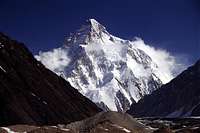 Other names: Mount Godwin-Austen or Chogori or Dapsang Other names: Mount Godwin-Austen or Chogori or Dapsang
Altitude: 8611 m, 28,251 feet
Location: China / Pakistan
First ascent: July 31, 1954 by Achille Compagnoni and Lino Lacedelli, Italian
Summits/Deaths: 354/82 or 23.16%
Challenge: Arguably the worldâs most difficult mountain to climb. Itâs high, steep, with a high risk for avalanches and rock fall. The weather is often bad and there are no easy route to the peakâs summit. It is technical climbing from start to end. The North Ridge is a bit easier but the approach through China is demanding and long.
My Experience: I summited K2 on July 27, 2014. I climbed with Garrett
Madison of Madison Mountaineering and Kami Sherpa once again. It was an incredible
climbed that started steep and never let up. The most fun was technical rock
climbing on the Black Pyramid at 23,000'.
3-Kangchenjunga
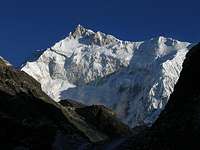 Other names: Kanchanfanga Other names: Kanchanfanga
Altitude: 8586 m, 28,169 feet
Location: India / Nepal
First ascent: May 25, 1955 by George Band and Joe Brown
Expedition: Great Britain
Summits/Deaths:332/48 or 14.46%
Challenge: Itâs one of the largest of the peaks of the 8000ers and the route to the summit is long. This fact and the many short, but technical sections place Kangchenjunga firmly in the higher end of the difficulty list. The altitude is also a factor.
4-Lhotse
 Altitude: 8516 m, 27.940 feet Altitude: 8516 m, 27.940 feet
Location: Tibet / Nepal
First ascent: May 18, 1956 by Ernst Reiss and Fritz Luchsinger
Expedition: Switzerland
Summits/Deaths: 604/19 or 3.15%
Challenge: The normal route share the South Col route on Everest and starts with the Khumbu Icefall. The altitude and exposure on the final climb to the summit are contributing to the peakâs reputation of being one in the middle of the list in terms of difficulty.
5-Makalu
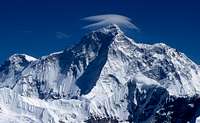 Other names: Makalufeng Other names: Makalufeng
Altitude: 8463 m, 27,838 feet
Location: Tibet / Nepal
First ascent: May 15, 1955 by Lionel Terray and Jean Couzy
Expedition: French
Summits/Deaths: 455/43 or 9.45%
Challenge: One of the more technical peaks and is amongst those considered hard climbs. Steep passages, both on rock and snow, exposure and avalanche danger makes this peak a tough target.
6-Cho Oyu
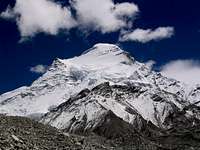
Altitude: 8201 m, 26,906 feet
Location: Tibet / Nepal
First ascent: October 19, 1954 by Joseph Joechler, Pasang
Dawa Lama and Herbert Tichy
Expedition: Austrian
Summits/Deaths: 3,508/50 or 1.42%
Challenge: Technically speaking the easiest of the 14. No technical climbing, but large snowfields and long distances. Many climbers donât reach the true summit, as itâs located some distance from where you enter the summit plateau and is only marginally higher than the fore summit.
My Experience: My first 8,000m peak. I climbed it from Tibet with IMG. A 5 week expedition, I reached 26,600' (8,060m) on the summit plateau before turning back. It was a learning experience that I never forgot.
7-Dhaulagiri
 Other names: Aulagiri Other names: Aulagiri
Altitude: 8167 m, 26,795 feet
Location: Nepal
First ascent: May 19, 1960 by Kurt Diemberger, Peter Diener, Nawang Dorje, Nima Dorje, Ernst Forrer and Albin Schelbert
Expedition: Switzerland
Summits/Deaths: 480/82 or 15.40%
Challenge: Considered to be a hard peak to climb by the pioneers in the area, but itâs nowadays considered as one on the lower half of the list. The normal route on the peak has some short technical sections and some avalanche danger, but overall itâs a quite straight forward climb.
8-Manaslu

Other names: Kutang
Altitude: 8163 m, 26,781 feet
Location: Nepal
First ascent: May 9, 1956 by Toshio Imanishi and Gyalzen Norbu
Expedition: Japanese
Summits/Deaths: 1,115/81 or 7.26%
Challenge: On the lower half of the peakâs normal route, avalanche danger is usually a main problem. Higher on the peak, the climb is mostly non-technical and easy. Manaslu has one of the higher death rates and is considered a dangerous peak.
My Experience: I summited Manaslu on September 25, 2013. The route was the most difficult in years due to a large avalanche in 2012 plus other mountain movements and a low snow year. The tiny summit was scary indeed!
9-Nanga Parbat
 Other names: Diamir Other names: Diamir
Altitude: 8126 m, 26,660 feet
Location: Pakistan
First ascent: July 3, 1953 by Hermann Buhl
Expedition: Austrian
Summits/Deaths: 335/68 or 20.30%
Challenge: Nanga Parbatâs normal route is not extremely technical, but itâs long and exposed. The mountain is infamous for bad weather and the route offers many tricky sections. Itâs considered as one of the harder peaks.
10-Annapurna
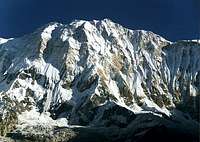 Other names: Morshiadi Other names: Morshiadi
Altitude: 8091 m, 26,545 feet
Location: Nepal
First ascent: June 3, 1950 by Maurice Herzog and Louis Lachenal
Expedition: French
Summits/Deaths: 255/71 or 27.84%
Challenge: Considered the most dangerous of the 14. The north and its original route is not that technical, but extremely avalanche prone. The south is of high technical Challenge and also holds lots of objective danger.
11-Gasherbrum I
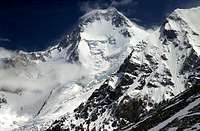 Other names: Hidden Peak or K5 Other names: Hidden Peak or K5
Altitude: 8068 m, 26,444 feet
Location: China / Pakistan
First ascent: July 5, 1958 by Andrew Kauffman and Peter Schoening
Expedition: U.S.
Summits/Deaths: 334/29 or 8.68%
Challenge: When the icefall and some easy ground have been covered, the climb gets more difficult. Steep mixed climbing and some objective danger makes Gasherbrum I a peak which belongs with the more difficult 8000ers.
12-Broad Peak
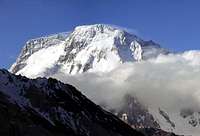 Other names: Falchen Kangri or K3 Other names: Falchen Kangri or K3
Altitude: 8047 m, 26,414 feet
Location: China / Pakistan
First ascent: June 9, 1957 by Hermann Buhl, Kurt Diemberger, Marcus Schmuck and Fritz Wintersteller
Expedition: Austrian
Summits/Deaths: 404/21 or 5.20%
Challenge: Considered a straight forward climb. The constant, but quite low angled steepness to the summit ridge can hold avalanche danger, but apart from that no technical surprises. Some rocky sections around the false summits and exposure offers the final test before reaching the true summit.
My Experience: I organized this expedition to climb Broad Peak
and then to "have a good showing" on K2. I reached 21,000' on Broad or Camp 2
before abandoning the climb due to weakness that resulted from a severe bug I
contracted on the trek in. The Karakorum ranges was magnificent and I was very
lucky to have unbelievable weather for the month I spent there. It was instrumental
having this experience for my summit of K2 in 2014. read more
13-Gasherbrum II
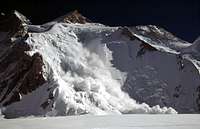 Other names: K4 Other names: K4
Altitude: 8035 m, 26,358 feet
Location: China / Pakistan
First ascent: July 9, 1956 by Josef Larch, Fritz Moravec, Hans Willenpart
Expedition: Austrian
Summits/Deaths: 930/21 or 2.26%
Challenge: Some years back G II was mentioned as one of the easiest 8000m peaks, usually together with Shishapamgma and Cho Oyu. After the âBanana Ridgeâsâ collapse the climb has become more difficult. The main obstacles are the huge icefall, crevasses, some steep climbing on snow and the exposure on the final part.
14-Shishapangma
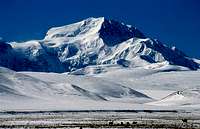 Other names: Gosainthan or Xixabangma Other names: Gosainthan or Xixabangma
Altitude: 8027 m, 26,335 feet
Location: Tibet
First ascent: May 2, 1964 by ten climbers led by Hsu Ching
Expedition: China
Summits/Deaths: 302/25 or 8.28%
Challenge: Considered as one of the easiest and it is a non-technical climb, to the fore summit, that is. The final part to the true summit is an airy and sometimes dangerous walk on a knife edge ridge and therefore a majority of climbers only reach the fore summit. The rest of the climb is easy, but sometimes avalanche prone.
My Experience: I attempted Shishapangma in September 2007. Weather
conspired to stop all but two climbers that year and no one reached the true
summit. I topped out at 7000m or 23,000' in excellent health and raised some
money for the Cure Alzheimer's Fund - so I was pleased. read more
|

